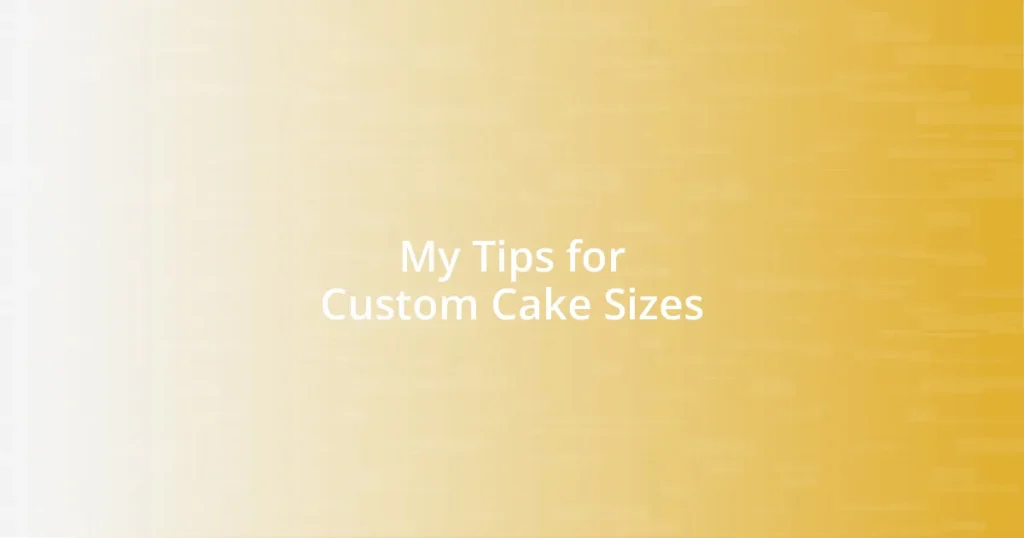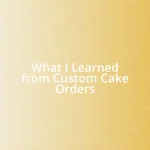Key takeaways:
- Understanding portioning and communication with clients is crucial for custom cake sizes to suit guest counts and event types.
- Factors such as guest count, event type, serving style, design complexity, and dietary preferences significantly influence cake size decisions.
- Accurate calculations of portions and adjustments in recipes are essential for achieving desired cake sizes and quality.
- Effective presentation through stands, color coordination, and garnishes enhances the visual appeal of cakes at events.

Understanding Custom Cake Sizes
When it comes to custom cake sizes, understanding portioning is key. I remember the first time I made a wedding cake—everyone had different ideas about how big it should be! This experience taught me that clarity with clients is crucial because different occasions and guest lists call for different sizes.
Consider this: how many people are you really serving? I once had a client who thought a three-tier cake would be enough for a small gathering, but they ended up inviting double the guests! Learning about actual serving sizes versus perceived needs can really help prevent situations where a cake is too small or too large.
It’s also essential to factor in the design and decoration. I’ve created beautiful multi-layered cakes that not only look stunning but also serve a crowd. Do you want a tall, impressive centerpiece or a more modest design? Understanding your vision and collaborating with a baker can transform your ideas into the perfect custom cake size.

Factors Influencing Cake Size
When considering cake size, several factors genuinely come into play. I recall a birthday celebration where the client was certain they needed a massive cake for just a few guests. After a conversation, we realized they wanted an impressive display, but also had to balance servings. This balancing act between aesthetics and practicality is where clear communication truly shines.
To give you a better idea, here are some factors influencing cake size:
- Guest Count: Always start with how many guests you expect.
- Event Type: A casual gathering might need a smaller cake compared to a formal wedding.
- Serving Style: Are you cutting slices or providing bite-sized pieces?
- Design Complexity: Intricate designs can affect how cake layers are structured.
- Dietary Preferences: Special requests (like gluten-free or vegan) may limit size options.
Understanding these elements helped me ensure the birthday cake was stunning yet appropriate for the celebration’s scale. It can be overwhelming, but once the right questions are asked, the ideal size becomes much clearer.

Calculating Portions for Cake Sizes
Calculating the right portions for cake sizes can be a bit daunting, but my experience has shown me that it’s all about math mixed with a pinch of creativity. I once found myself navigating a client’s request for a cake for 50 guests but ended up with a formula on my hands. By using a simple rule of thumb, which suggests that a standard slice is about 1 inch by 2 inches for a layered cake, I could easily determine the cake size needed. This little trick has saved me from many last-minute panics!
Moreover, the tiered cakes often add another layer of complexity when calculating portions. Each tier can be a different flavor or design, and I fondly remember a wedding with a three-layer cake that hosted a blend of vanilla, chocolate, and lemon. It’s generally accepted that a 6-inch, 8-inch, and 10-inch tier can serve about 30, 50, and 70 guests, respectively. I still smile thinking about how the couple cut into that cake and the delighted reactions of their loved ones as they shared the different flavors.
While portion calculations provide a good start, always consider the unique elements of each celebration. I find that asking questions about the event’s atmosphere—like whether they prefer generous slices or smaller, more delicate pieces—can significantly impact the final decision. This insight often leads to a more personalized cake that leaves everyone satisfied and happy.
| Cake Size | Estimated Servings |
|---|---|
| 6-inch Round | Serves 12-18 |
| 8-inch Round | Serves 24-32 |
| 10-inch Round | Serves 38-56 |
| 12-inch Round | Serves 56-80 |
| 2-Tier Cake (6″ + 8″) | Serves 36-50 |
| 3-Tier Cake (6″ + 8″ + 10″) | Serves 70-90 |

Common Sizes for Different Events
When planning a cake for a child’s birthday party, I’ve found that a 1-tier, 8-inch cake usually fits the bill perfectly. It serves around 24 to 32 guests, which is just enough for their little friends and fills the table without looking too overwhelming. It’s amazing how a colorful design with fun elements can make even a modest cake feel like the star of the show, isn’t it?
For a wedding, I often suggest going big with a multi-tiered option. I remember a stunning outdoor wedding where we created a 3-tier cake, with each tier being different flavors. It served about 70 to 90 guests, and the couple was over the moon about how it not only fed their guests but also served as a breathtaking centerpiece. Who doesn’t love seeing that “wow” factor when the cake is revealed? I believe it’s essential to consider not just the number of guests but also the overall atmosphere of the event.
Also, don’t underestimate the charm of a small gathering. A cozy engagement party I catered had a delightful 6-inch cake, which was just right for the intimate crowd of about 12 to 18 people. It brought everyone together for that “first slice” moment that still brings a smile to my face. Just think about how the perfect cake can enhance those memorable experiences—not just for the taste, but for the joy it sparks among friends and family.

Adjusting Recipes for Custom Sizes
When I adjust a recipe for a custom cake size, I always think about the ingredients proportionally. For instance, when I had to make a larger cake for an anniversary, I found that simply doubling the ingredients didn’t yield the same delicious results. I learned the hard way that sometimes, tweaking specific ingredients, like reducing the liquid slightly, could yield a better texture and flavor in the final outcome. Don’t forget that baking is as much about science as it is about art!
I also find it helpful to keep track of the baking times when changing sizes. The first time I made a 12-inch cake, I was so caught up in the excitement that I neglected to adjust the baking time, resulting in a cake that was undercooked in the center. Since then, I’ve made a habit of researching the baking duration for different sizes, ensuring each layer bakes evenly. Have you ever had a moment like that? When everything hinges on a single cake, knowing how to get the timing just right can be quite the relief!
Finally, I can’t stress enough the importance of testing your recipe ahead of time. For a friend’s small business opening, I perfected a 10-inch cake by trial and error. Even though it was meant to serve 38 to 56 guests, I wanted to ensure the flavors were spot on. I ended up doing a test run with a smaller version, which not only fine-tuned my baking skills, but also calmed my nerves for the big day. There’s a joy in seeing your adjustments turn into a cake that delights both the palate and the eyes. Isn’t that what it’s all about?

Presentation Tips for Custom Cakes
One of the most crucial aspects of cake presentation is the choice of stands and platters. I remember setting up a dessert table for a baby shower, and I used various heights to create visual interest. An elegant cake stand can elevate your cake, making it feel special and inviting. Have you ever noticed how a cake displayed on an ornate stand seems to beckon you?
Color coordination is another key element in presentation. For a birthday celebration, I once paired a vibrant chocolate cake with pastel decorations and matching tablecloths. The way the colors danced together created a cohesive look that made the cake look even more inviting. I believe it’s all about harmony; it’s amazing how a few thoughtful touches can enhance the overall theme of the event!
Don’t overlook the power of garnishes, either. I once adorned a lemon cake with fresh berries and mint leaves for a summer wedding, and the lively colors popped against the soft yellow of the cake. It reinforced the cake’s freshness and was truly a visual treat. The right garnishes not only enhance the appearance but also give guests a hint of what to expect in terms of flavor. Isn’t it delightful when a cake looks so good that it sparks curiosity before it’s even tasted?

Troubleshooting Cake Size Issues
When troubleshooting cake size issues, I often find that the wrong pan size can lead to unexpected outcomes. Once, I baked a cake meant for a 9-inch round pan in an 8-inch pan, thinking it would work out just fine. The cake overflowed and left me with a messy kitchen! Now, I always double-check the size needed for my recipe before diving in. Have you experienced that moment of panic when a cake starts to misbehave?
Another common pitfall involves ingredient adjustments. I recall the first time I made a huge tiered cake and accidentally doubled the sugar instead of just increasing it proportionally. The sweetness was overwhelming, and I was heartbroken. Since then, I’ve learned to meticulously calculate not just the volume but also the ratio of flavors, like how much sugar or baking powder to use in larger batches. It’s about respecting the balance of the ingredients!
Lastly, understanding the relationship between baking time and cake size has been a game changer for me. I remember conceiving a lovely 14-inch cake that took much longer to bake than I anticipated. I learned to use a toothpick tester more frequently as the cake grew; it’s amazing how a simple tool can save you from a sunken disaster! Do you ever find yourself adjusting your approach based on size alone? Each experience has deepened my insight into the nuances of baking and has made me appreciate the process even more.















